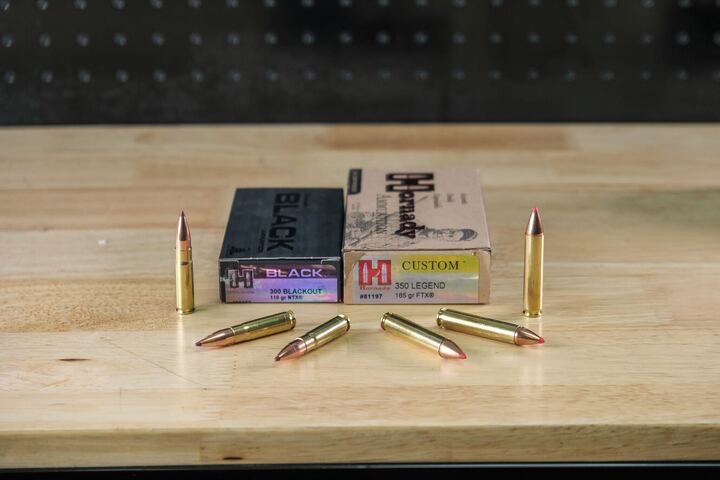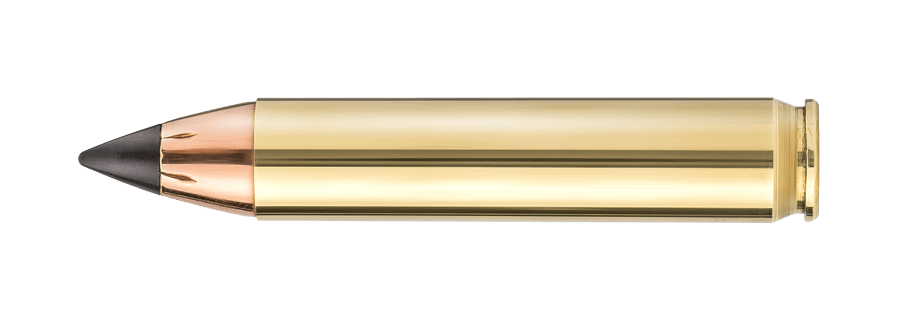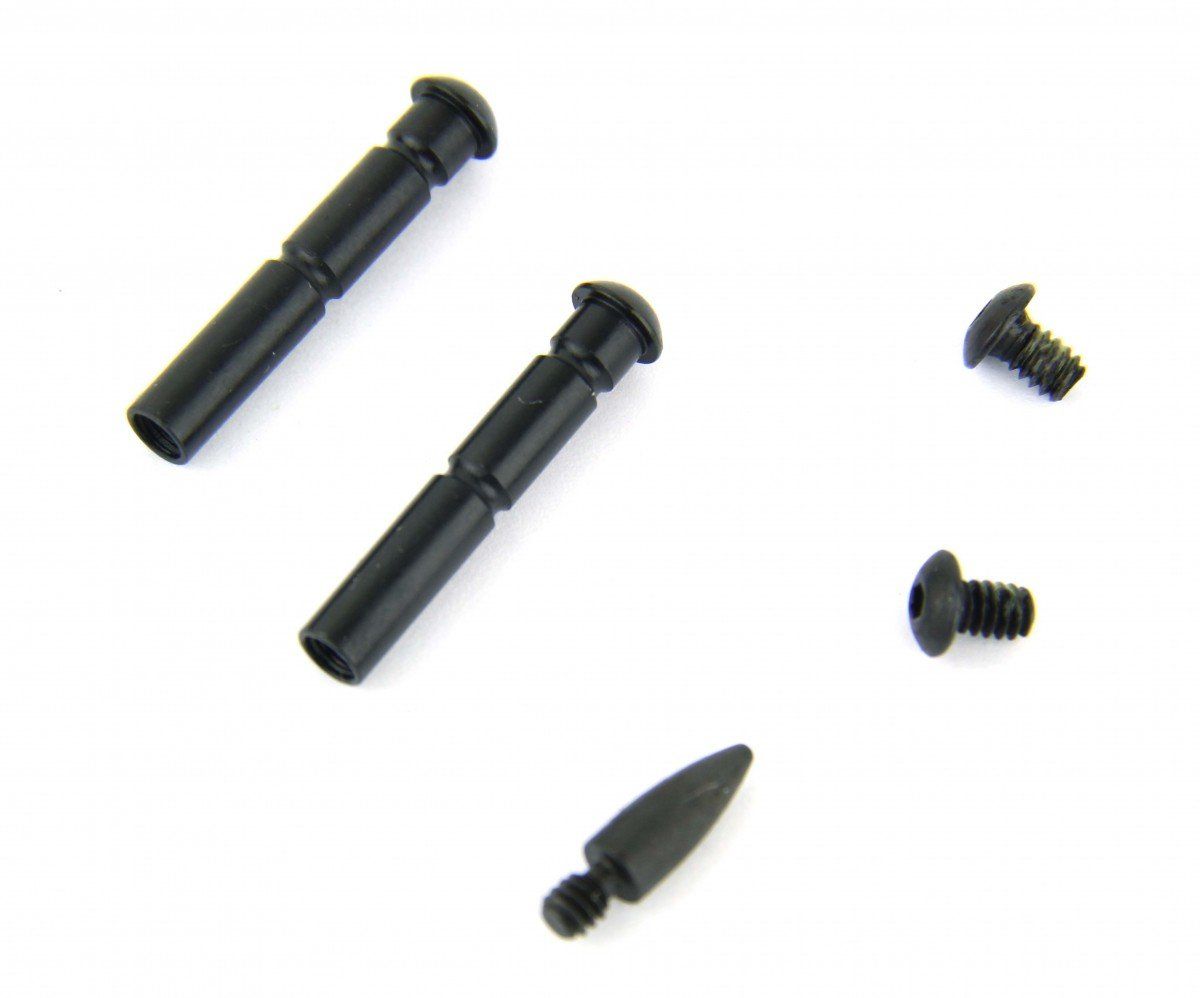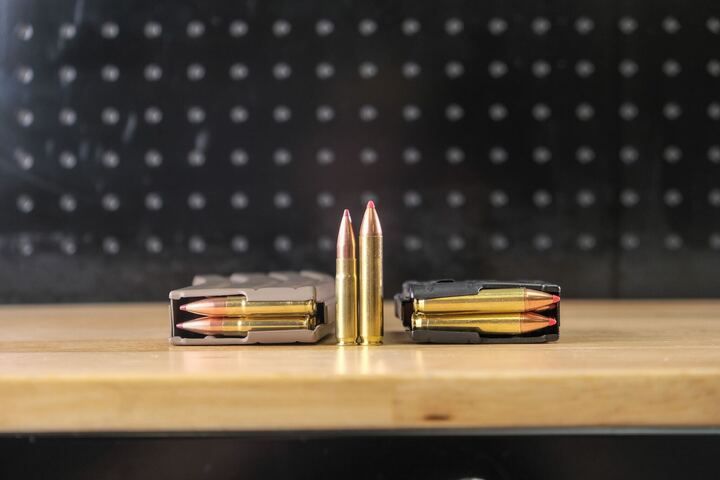Subtotal: $10.95
You’ll see a lot of debate online and in forums about 300 Blackout Upper Receiver versus 350 Legend Upper Receiver, which we can cut short here – if you’re building something that’s not super specialized and hunting-specific, we will steer you towards 300 Blackout. That was simple, wasn’t it? If only it was actually that easy.
The debate between 300 Blackout and 350 Legend centers on their unique capabilities, with each cartridge excelling in different areas. For example, my personal choice for an all-around defensive is an 8-inch 300 Blackout SBR loaded with Barnes Blacktip 110-grain rounds and topped with a Rugged Razor suppressor. This setup is highly effective across various applications, from home defense to small game hunting, offering adaptability, ease of use, and devastating performance. However, the 350 Legend also shines as a dedicated hunting cartridge, particularly in straight-wall states, making it a compelling option for certain users.

While consider purchasing a AR-15 upper receiver, the 300 Blackout Upper Receiver is often favored for its versatility, the 350 Legend Upper Receiver was designed with a more specific purpose in mind. Each cartridge meets the needs of different shooters based on their goals. For tactical applications, home defense, and those who require flexibility with both supersonic and subsonic ammunition, the 300 Blackout stands out. Meanwhile, hunters operating in states with straight-wall cartridge regulations or those focused on deer and hog hunting at moderate ranges will appreciate the design and power of the 350 Legend. Let’s take a closer look at how each cartridge performs in their respective roles.

300 Blackout: Optimized for Short Barrels and Supersonic Performance
One of the standout features of the 300 Blackout is its exceptional performance through short-barreled rifles, even when using supersonic ammunition. While much has been made about the round’s ability to run subsonic, 300 Blackout isn’t just a subsonic platform. It excels in short barrels with supersonic loads, providing high velocity and devastating energy at close to medium ranges. Even in a suppressed configuration, running supersonic ammunition through a 300 Blackout SBR offers a compact, quiet, and effective setup. Whether you choose to suppress it or not, 300 Blackout performs beautifully with supers in short barrels, making it a versatile and powerful option for both home defense and tactical applications.

Addressing Magazine Issues with 300 Blackout
While I never experienced issues, some early users of 300 Blackout found some challenges when using it in standard 5.56 magazines. Since 300 Blackout rounds are significantly heavier, especially when using rounds like the 220-grain subsonics, the spring tension in 5.56 AR-15 magazines can sometimes lead to feeding issues. This is because the magazine’s spring wasn’t designed to handle the increased weight of 300 Blackout rounds, which can cause misfeeds or malfunctions. Magpul’s 300 Blackout-specific magazine addresses this issue by adjusting spring tension to better support the heavier, sharper 300 Blackout rounds.

One thing to consider is the bullet profile itself. Many 300 Blackout rounds, particularly supersonic ones, have a more aerodynamic design compared to traditional 5.56 bullets. This sharpness can cause drag inside the magazine, sometimes leading to nose-dive feeding issues. The specific 300 Blackout Magpul magazines have been designed to mitigate this by smoothing the path for these sharp bullets, preventing them from catching and causing feeding problems.

Defensive Round of Choice
One of the top-performing rounds for defensive use is the Barnes VOR-TX Ammunition 300 AAC Blackout 110-Grain TAC-TX. Frankly, if there’s something better out there, let us know. This round delivers excellent terminal performance and is ideal for home defense situations. The combination of stopping power and reliable expansion makes it a favorite among 300 Blackout users looking for a defensive round that delivers every time. It’s been almost a decade now, and this is still the go-to, in our opinion. We also know from a very reliable source who uses this round for use with his deer eradication permit, that there is nothing, we mean nothing, better for whitetail.
350 Legend’s Purpose-Built Design
Alas, what if the incredible 110 grain 300 Blackout isn’t an option due to oddball regulations? Well that’s where the Legend is born. The 350 Legend was developed by Winchester in 2019 to meet the needs of hunters in states with straight-wall cartridge regulations. States like Ohio, Michigan, and Indiana require hunters to use straight-walled rifle cartridges for deer hunting, making the 350 Legend an ideal solution. While it may be labeled a “350,” the bullet diameter is actually .357, allowing it to meet these strict legal requirements. Designed from the ground up for hunters, the 350 Legend is capable of taking down medium-sized game at distances up to 250 yards, making it a pure hunting cartridge.

Conversion Ease: 300 Blackout vs. 350 Legend
One of the appealing aspects of both 300 Blackout and 350 Legend is their compatibility with the AR-15 platform. Converting a standard AR-15 chambered in 5.56 NATO to 300 Blackout or 350 Legend is a relatively simple process, requiring only a barrel swap. However, there’s one key difference: 300 Blackout works with standard AR-15 magazines, while 350 Legend requires dedicated magazines due to its straight-walled design. This makes 300 Blackout a bit more convenient for those already heavily invested in the AR-15 platform and looking for a quick, versatile conversion.
Ballistics and Range: Trajectory Matters
When comparing ballistics, the 350 Legend offers a flatter trajectory than the 300 Blackout, especially at distances around 200 yards. For example, using Winchester’s Deer Season XP 150-grain loads, the 350 Legend experiences roughly 7.6 inches of drop at 200 yards, while the 300 Blackout sees about 9 inches of drop. Though this difference is minimal at close range, it becomes more pronounced at longer distances, where the 350 Legend’s higher velocity helps maintain a flatter flight path.
This higher velocity also allows the 350 Legend to achieve greater muzzle energy—up to 1,800 foot-pounds compared to 1,200 foot-pounds for the 300 Blackout, making the 350 Legend more suited for medium-range deer hunting. However, the 300 Blackout remains extremely effective within 150-200 yards, particularly for hogs and smaller game, where rapid follow-up shots and versatility with ammo types are more crucial.
Hog Hunting: 350 Legend’s Penetration Advantage
While 300 Blackout can be used effectively for hog hunting, the 350 Legend does offer some advantages for larger hogs. In tests, the 350 Legend has shown excellent penetration, with rounds passing through shoulders and expanding effectively to create large wound channels. For example, a large boar hit with a 350 Legend round showed a nickel-to-quarter-sized exit wound and dropped quickly with a single shot. This kind of performance makes the 350 Legend a strong contender for those hunting larger hogs in areas where straight-wall cartridges are required.
That said, 300 Blackout, especially when using premium rounds like the Barnes Blacktip, can still take down hogs with proper shot placement, particularly for smaller and medium-sized hogs. It offers the added benefit of less recoil, which can be crucial for follow-up shots in fast-paced hunting situations.

Sectional Density and Penetration
Sectional density plays a critical role in how well a bullet penetrates its target. Though Winchester hasn’t published official sectional density data for the 350 Legend, comparisons with Hornady loads suggest that 300 Blackout has an edge in penetration. For example, Hornady’s 135-grain FTX Custom 300 Blackout round has a sectional density of 0.203, compared to a 165-grain 350 Legend round with an SD of 0.187. This suggests that 300 Blackout may penetrate deeper, making it particularly useful for tougher game.
Conclusion: Balancing Versatility and Purpose
While both cartridges excel in their respective fields, the 300 Blackout offers broader versatility for shooters who need a do-it-all round. My 8-inch 300 Blackout SBR with Barnes Blacktip 110-grain rounds and a Rugged Razor suppressor continues to impress, providing effective results in both home defense and hunting. Its ability to perform in both suppressed and unsuppressed configurations makes it a flexible choice for a wide range of shooting applications.

The 350 Legend, however, remains an excellent cartridge for hunters in straight-wall states or those targeting medium game at mid-range distances. Its higher energy, flatter trajectory, and straight-walled design make it ideal for deer and hog hunting within 250 yards. For those primarily focused on hunting in specific regions, the 350 Legend might be the better option.
Ultimately, the choice between 300 Blackout and 350 Legend depends on your intended use. If you need a versatile round that works across various platforms and scenarios, 300 Blackout is hard to beat. But if you’re a hunter focused on medium-range game in a straight-wall cartridge state, the 350 Legend is a purpose-built option that will serve you well.


FYI, I live in Indiana and 300 BLK IS legal for deer.